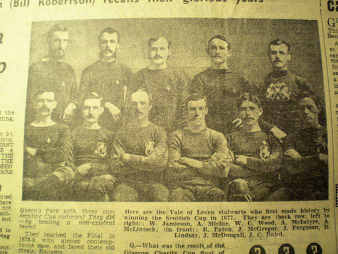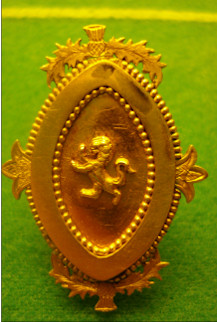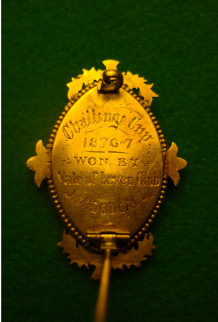Organising the Game in Scotland
This “coming of age” game for the Vale could not have come at a better time, because less than two weeks later football in Scotland started to organise itself more formally. On the 13th March 1873 a meeting was held in Dewar’s Temperance Hotel in Bridge Street, Glasgow at which the Scottish Football Association (the “SFA”) was formed and a national cup competition, The Scottish Cup or Challenge Cup, as it was known at that time, was established. Seven teams attended the meeting:
- Queen’s Park
- Clydesdale
- Vale of Leven
- Dumbreck
- Third Lanark
- Eastern
- Granville
Kilmarnock did not attend but sent a letter stating their willingness to join the SFA.
These eight teams are therefore regarded as the founder members of the SFA and of the Scottish Cup competition. The first President of the Vale of Leven FC, Mr Donald McFarlane, was also elected to the very first Committee of the SFA. All the Clubs contributed £1 each to-wards the cost of the Scottish Cup at this time. However, the competition took some time to organise and the first round games in the first Scottish Cup competition were not played until October 1873. The competition carried on into 1874, and the period of the Cup competition came to be called season 1873-74, with every season since following on with that notation.
The period between that first meeting in March 1873 and the start of the first Cup campaign in October 1873 was put to good use by the SFA. It contacted other clubs to get them involved and it also solicited further contributions to pay for a trophy. By the time the cup was produced by George Edward & Sons, the princely sum of £41 12 shillings had been raised from the following 15 football clubs:
- Kilmarnock £1
- Dumbreck £2 2shillings or 2 guineas as it was in those days
- Renton £1
- Callander £1
- Blythswood £1
- Eastern £1
- Western £4
- Vale of Leven £1
- Third Lanark RV £3 guineas
- Alexandria Athletic £3
- Dumbarton £1 10 shillings
- Rovers £1 5 shilling
- Granville £2 guineas
- Clydesdale £5
- Queens Park £5
Other donations raised the total to £41 12 shillings. For the Challenge Cup, 11 silver-gilt badges and the engraving, George Edward charged £56 12 shillings and gave the SFA a little time to raise the difference.
The Scottish Cup trophy which is played for just now is that original cup made by George Edwards in 1874.and is the oldest footballing trophy in the world which is still competed for annually. This is because in the early years of the English Cup, the English Football Association very generously let any team which won it three years in succession keep it permanently. Unfortunately, this was not an approach which was followed by the SFA; otherwise by 1879 the Vale would have been the proud permanent owners of a Scottish Cup trophy – which would have been the second such trophy, because Queen’s Park had already won it 3 years in succession 1874-76.
The John Ferguson Affair
As can be seen from the above contributors list, some of the founding clubs increased their donations between March and October 1873 when the first-ever competition kicked off. The Vale did not, which turned out to be a very wise move, because the Vale did not play in the Cup competition in its first two seasons, 1873 – 74 and 1874-75. They entered it in both seasons and were duly drawn to play first-round opponents. However, in each of these years their 1st round opponents protested about the professional status of one of the Vale’s outstanding players – John Ferguson. On 18th October 1873 they should have played local rivals Dumbarton but Dumbarton protested about Ferguson, and had their protest upheld by the SFA. In 1874 it was Glasgow club Clydesdale who protested. The matter became known as the “John Ferguson Affair” and was replete with the self-serving hypocrisy for which the SFA has become a by-word over the years. Its members started down that road at their first opportunity.
The controversy was caused by the SFA’s first set of rules for the Scottish Cup, which like the SFA constitution, had been largely drawn up by Queen’s Park’s middle class members. They had imposed their own highly selective amateur views on these early rules. Queen’s were supported by other Glasgow clubs which were also largely middle class or drawn from the Volunteer movement (Third Lanark RV). One rule in the SFA constitution was crystal clear and seems to have been agreed by all members: clubs could not pay players for playing football. At the outset that was a sensible rule because clubs did not have the money to pay their players. The income which soon flowed in went to pay off the debts incurred in setting the clubs up – buying and / or laying out grounds, acquiring strips or uniforms, balls etc. It was almost 20 years before that rule was changed, and long before then it was more breached than observed.
However, it was quite another rule, one which applied only to players participating in Scottish Cup games, which was invoked to bar Johnny Ferguson: no one who had been paid for participating in any sport whatsoever could play in a Scottish Cup tie. Like many other Vale and Renton players, Ferguson was an accomplished athlete with a national reputation. Before he came to football he had carved out a reputation as a runner, winning many high-profile races and being paid for them. Far from denying this, he was quite proud of it. Jamestown-born, he had been sent out to work in the local printfields at 9 years of age and now in his 20’s he was delighted to supplement his wage with prize-money from his running. As indeed were other members of the Vale team who did not quite have the profile of Ferguson. When Dumbarton claimed there were “one or two others that we could also protest about” in the Vale team they were quite right and the Vale never denied it.
What John Ferguson and his Vale colleagues did do, then and for as long as they lived, was to point out the inherent absurdity in that rule: under its terms anyone who had ever received 6 pence for winning a Sunday School race should also be barred. Having stated their position, they declined to carry that line of argument any further, although well understanding the stupidity of the rule and the selectivity of its supporters. Instead, the Vale withdrew in a dignified fashion, refusing to play without Johnny Ferguson and therefore did not take part in the Cup in these its first two seasons.
The hypocrisy of the newly-formed SFA came into sharp relief when right in the middle of this dispute, the “blazers” made what was in the circumstances a stunning decision – they picked Ferguson to play for Scotland in the third international game against England, in 1874. This made him the first Vale player and the first Scottish club player from outside of Glasgow to play for Scotland. How on earth could it have been permissible for him to play for Scotland, but not ok for him to turn out for the Vale in the Cup? Quite simply, when playing for Scotland he didn’t threaten Queen’s Park, Dumbarton or any other Scottish club, and as an added bonus the blazers could bask in the reflected glory from a good performance by Ferguson – and he delivered many of those for Scotland.
Just how much of a farce it all was is best shown by the way the dispute ended. The second President of the Vale FC, A S McBride, was also elected as the second President of the SFA in 1875, serving from 1875 -76. During his tenure the rule was quietly dropped, never to be heard of again (more, however, will be heard about McBride, a high profile character in the Vale and in Scottish football generally, who was one of the donors of the Loving Cup, 20 years or so later). It could be argued that in this case the Vale also played the self-interest card. However, the rule would never have survived the rigourous interpretation that McBride could have put on it, so it had to go. The Vale played their first cup game in season 1875 – 76 and from then on John Ferguson, and all the others who had won money in sports other than football, including at Sunday School trips, were free to play in the cup. The rule barring clubs from paying players, however, remained intact at this stage, just biding its time to become a divisive issue in the game in the 1880’s.
Renton’s First Cup Final
What made this two season delay even more galling for the Vale was the fact that their local arch rivals, Renton, got to the Cup Final in its second year of competition, 1874-75, where they were beaten 3-0 by Queen’s Park. To say that Renton’s achievement came as a great surprise to everyone, themselves included, is something of an understatement. However, it indicated two or three things which were just as true a mile or so away in Alexandria. Firstly, Renton and Vale players were very fit, probably on average fitter than most of their opponents. Secondly, they had very quickly picked up the basic footballing skills of dribbling, ball control and passing. Thirdly, they were tactically aware, spending time planning tactics – famously with beer bottles acting as players on a table top acting as a pitch. All they needed to add was experience.
A typical season before the League was formed
The Scottish Cup was the only organised competition until the formation of the Scottish League in 1890, but by its very nature – half the clubs were eliminated in the first round, half again in each successive round – it wasn’t a steady source of games and thus of revenues. All other matches were organised on an ad-hoc basis between the clubs themselves. These were known as “club” games, but we would now call them friendlies. These were the staple diet for the football clubs. In the first 4 years of the Vale’s existence they played about 6-7 club games per season and these were popular with the paying public. The Vale itself soon became a big draw in Glasgow, while Queen’s and Third Lanark could bring in crowds of 1,500 – 2,000 in Alexandria, while local derbies against Renton drew even more. These games were the main revenue source for most of the clubs and both the Vale and Renton were in great demand to play in them.
So when in November 1875 Queen’s Park withdrew from a commitment to play a club game against the Vale because they had to play a Cup game on the agreed date, and did not offer an alternative date, they were offending the Vale twice over. They were not only rubbing salt in the Vale’s wound of not playing in the Cup, but also they were depriving the Vale of a money-spinning game which they had been promised and which they felt was their due. Things went down-hill pretty sharply with a terse exchange of letters and when the Vale published their side of the story and the correspondence between the two clubs in the Glasgow newspapers, they were at the centre of a second furore. Its perhaps not too surprising that some thought them “difficult” and “touchy”, but its equally valid to retort that Queen’s were arrogant, selfish and acting in bad faith throughout the dispute. The matter provided the rest of Scottish football with some harmless entertainment for a few years, while the two teams refused to organise club matches against each other. The Scottish Cup was quite another matter. If they were drawn against each other, then they had to play or forfeit the tie. This duly happened in the first season which the Vale actually got to play in the competition and the game was played. The two clubs did not patch up their differences until early 1878, when the matter was quietly resolved and hostilities ceased.
The Vale in the Scottish Cup
Having disposed of the John Ferguson affair, and having watched Renton get to the Cup Final in 1875, Vale were desperate to get their cup campaign up and running in season 1875-76. It should have started with a first round tie against another Vale team, Vale of Leven Rovers, but Rovers scratched. Instead, on November 13th 1875 a second round tie against the previous year’s finalists and fierce local rivals, Renton saw the Vale off on a 50 year journey in the Scottish Cup (plus another 10 with Vale Ocoba). They couldn’t have had more appropriate opponents. The game was played at Alexandria in front of a crowd in excess of 1,500 and the Vale won 3-0. It’s worth listing both of these local teams:
Vale: WC Wood, W Jamieson, A McIntyre, J McIntyre, A McLintock, J Ferguson (capt), R Paton, JC McGregor, James Baird, JC Baird, J McDougall
Renton: R Turnbull, A McKay, J Kennedy, J Scullion, P Joyce, J McCrae, Miller, L Brown, Melvin, R Glenn, McCrimmon
Another couple of wins took the Vale to a semi-final match against Queen’s Park, the Cup holders and at this time their bitter enemies. Vale went down to a narrow 2-1 defeat to a team which had never been beaten in the Scottish Cup, in front of a crowd which some thought might have reached 10,000. But getting to the semi-final at their first attempt was some consolation and they could look forward to the following season’s campaign with some confidence, especially as after that semi-final many independent observers saw the Vale (and a few others) as “coming up fast” on Queen’s Park.
Season 1876 – 77 – The Vale’s First Cup win
So the Vale approached season 1876-77 with some confidence. It proved to be a very eventful season in a number of different ways. A third round victory by 1-0 over Third Lanark in November 1876 was reported to be “one of the most brilliant games ever for the Scottish Cup”.
This took them into a quarter final tie on 30th December 1876 against holder’s Queen’s Park, with the two clubs still at daggers drawn. Played in the wind and rain, it was that old cliché “a game of two halves”. It’s also fair to say that it was the start of a run of good luck in the Scottish Cup which was to come to the Vale’s aid a number of times, much to the anger of their opponents. At half-time Queen’s were a goal up and another goal-bound shot from a Queen’s player had been diverted past the post by accidentally hitting the umpire’s umbrella. The first major piece of good fortune for the Vale in the Cup, but there many more to come in the next few years. In the second half, the Vale equalised through a goal which Queen’s claimed should not have been given because of a hand ball in the lead-up. The referee did not see a foul and the goal stood. A second Vale goal gave the Vale a 2-1 win and inflicted on Queen’s Park their first defeat in the Scottish Cup, and indeed their first defeat by a Scottish club in any match. This was sweet revenge for the Vale after years of real and perceived slights inflicted by Queen’s and the coterie around them. Hogmanay came a day early back in the Vale when the victorious team returned home.
Queen’s liked to portray themselves as a “gentleman’s club” with a “gentleman’s code of behaviour”. Their reaction to the defeat showed the limitations to a gentleman’s code of behaviour, whatever that may be. On the Tuesday after the game they claimed to have found spike marks on the pitch at Hampden with the implication being that at least one of the Vale players had been wearing spikes in the wet conditions. They even went so far as sending a couple of their officials down to the Vale to go to the homes of the Vale players to inspect the boots they wore during the game. Surprisingly, instead of placing the boots in the backsides of these graceless whingers, the Vale players actually showed them the footwear. It was all spurious nonsense, of course, and it quietly withered on the vine, but Queen’s had lost some more of their self-appointed moral authority.
It did not deflect the Vale from their Cup campaign and they proceeded to their first Cup final, after they easily disposed of Ayr Thistle by 9-0 in the semi-final. In the final they met Rangers, who had also made it to their first final and what an epic, incident packed struggle it turned out to be.
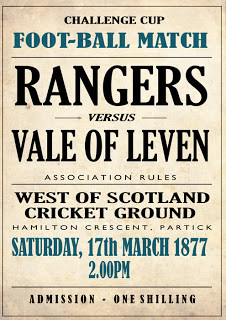 The first game on 17 March 1877 was drawn 1-1 and a replay was required the following week. This turned out to be a game of considerable controversy. It was a 1-1 draw at full time and an extra 30 minutes were being played, pretty uneventfully, until with 10 minutes to go, Rangers shot and the Vale goal-keeper Woods pushed the ball away. Rangers claimed the ball had already crossed the line, and the crowd invaded the pitch. One umpire (an early form of referee’s assistant) gave a goal the other said it hadn’t crossed the line. The referee readily admitted that he had been too far away to tell, and that he couldn’t give what he hadn’t seen, which is still the case to-day.
The first game on 17 March 1877 was drawn 1-1 and a replay was required the following week. This turned out to be a game of considerable controversy. It was a 1-1 draw at full time and an extra 30 minutes were being played, pretty uneventfully, until with 10 minutes to go, Rangers shot and the Vale goal-keeper Woods pushed the ball away. Rangers claimed the ball had already crossed the line, and the crowd invaded the pitch. One umpire (an early form of referee’s assistant) gave a goal the other said it hadn’t crossed the line. The referee readily admitted that he had been too far away to tell, and that he couldn’t give what he hadn’t seen, which is still the case to-day.
It proved impossible to clear the pitch and the referee had no option but to declare the match drawn. This may well have been a lucky escape for the Vale, but then again who’s to say it was a goal, or that the Vale wouldn’t have equalised or even gone on to win in the final 10 minutes?
In a rehearsal for what was to come a few years later, Rangers threatened not to turn up for the second replay. However, wiser counsels prevailed and they were at Hampden on Friday 13th April 1877. This had to be an unlucky Friday for one of these teams and their supporters, as the teams tried to settle the matter at the third time of asking in front of at least 12,000 spectators. In an ill-tempered game the Vale ran out 3-2 winners.
Back in the Vale, joy was unconfined. The team toured Alexandria in an open carriage, cannon were fired, although goodness only knows where they came from, and people celebrated. As well they might. The Vale had been excluded from the Cup in its first two years, had been beaten by the cup holders in their first year of participation, and now in only their second attempt they had won it. If they had carried a bit of luck along the way, then they had also had had to endure baseless accusations of cheating by an arrogant Queen’s Park, at the time Scotland’s premiere club.
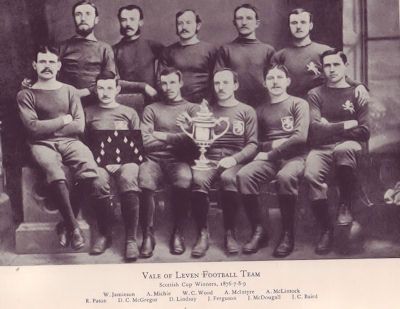
The Vale Team which won the Cup in 1877 are picture above.
The tray of badges being held by JC McGregor
(not “DC” as the caption shows) includes
John McDougall’s badge which is mentioned below.
We received an email from Robert Lindsay, an ex pat now living in the south of England. Robert tells us that his father was Lawrance (Lawrie) Lindsay, a Valeman who worked in the RNTF before moving to Garelochhead as the MOD presence was being built up in that area. Lawrie also played for Dumbarton FC.
Robert sent us the image below, which is of the "Vale of Leven Stalwarts" football team who won the Scottish Cup in 1877. His Uncle David is pictured in this famous team.
Robert points out that "The Vale" beat Vale of Leven Rovers in the second round. This link is to the Wikipedia website where that full results from that year's competition are listed. The importance of this area in the development of football is very much in evidence on this list.
Richard Turner is a collector of football memorabilia who found the medal pictured below in a jewellers shop in Glasgow about 6 years ago. It was being sold simply as a 9ct ladies brooch.
The medal is engraved
Challenge Cup
1876-7
Won By
Vale of Leven Club
J. McDougallRichard says, "As soon as I saw it's inscription I knew what it was as I like to read about the early history of football and knew about The Vale of Leven's early football achievements.
As for John McDougall I only know what I have read, he was the first ever International to score a hat-trick in the 7-2 win Scotland v England in 1878, he played in all 3 winning finals of 1877-78-79, he captained the Vale team that travelled down to London in 1878 to play against the Wanderers (5 times winners of the F.A. cup) and won 3-1. He was certainly an outstanding player of his time."
See also - seasons that fixed a place in History for the Vale of Leven. (Evening Times >)
Next - Season 1877 – 78 A second Cup win in succession and a first trip down South >

